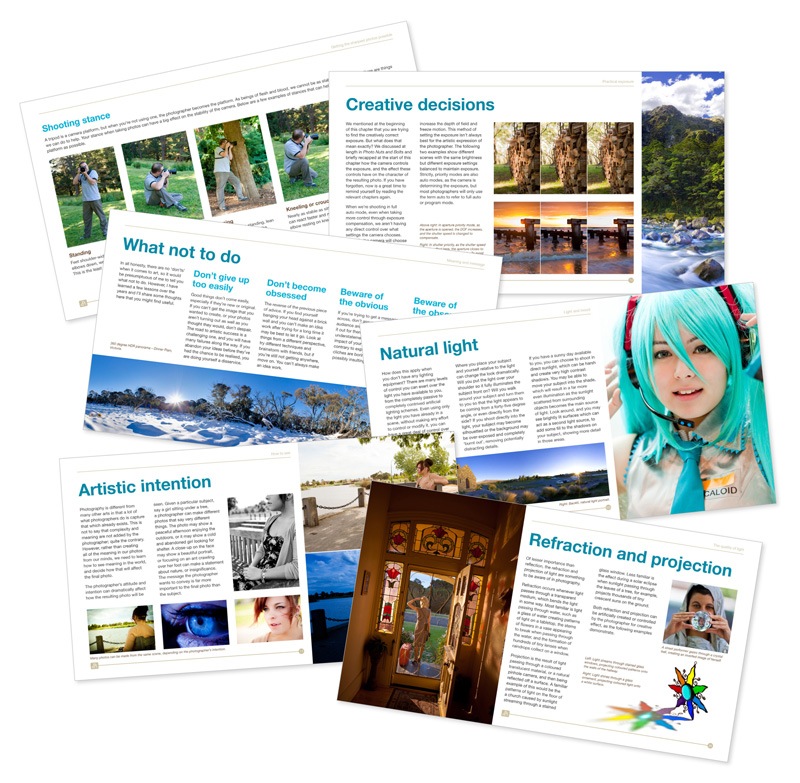Tony Page reviews the latest ebook from the Digital Photography School
If you’re on any photography connected list, you’ve probably heard (there’s been a lot of sales emails from the usual suspects) that Darren Rowse has just put out another ebook under the Digital Photography School banner, and it may be of interest to you (or it may not, read on to find out or bail now to save yourself a minute or two).
Called "Photo Nuts and Shots", this one is a follow-up to a previous book "Photo Nuts and Bolts", which was put together by DPS staff writer Neil Creek based on his blog posts. It’s the first book by Neil with entirely new contents and he’s written and photographed it himself.
(By the way, the ebook actually isn’t in the format represented in the image on the right, see below)
If you want to check out the sales page, it’s here:
Photo Nuts and Shots (yep, that’s an affiliate link, I get about US$6 if you buy the book, but I suggest you read my review first to find out whether you should).
To start with let me declare an interest, Darren helped me market my own Guerrilla Travel Photography book last year, and he’s one of the most reputable personalities on the internet: this alone is enough to make many people buy anything he produces on trust if they’re in any way interested in the subject matter. Apparently he’s sold 3777 of "Photo Nuts and Shots" in the first week and that’s basically sight unseen, so there’s no doubt this one will be as successful as those DPS books he’s marketed in the past.
So should YOU consider buying "Photo Nuts and Shots"?
It’s certainly a bargain price at US$14.95 during the initial launch period (which ends in a week’s time or so, around February 11). And you’ll get a one in gazillion chance of winning a new Sony DSLR along with your purchase. But the real question is whether it’s right for you – are you going to get anything out of it, is it worth you spending both your time and money on it?
Well, my answer to that is, it depends.
If you’re a dead tree person (admission: I often am) and want to print it out, probably not, because it’s in a 16:9 widescreen format and doesn’t fit either A4 or letter size paper very well. Looks fine on screen though.
Click to see full-size
Neil’s strength is clearly in his landscape photography, and he has some excellent examples of his work. His book is really a personal statement of his own approach to photography, which he decided to take up professionally a year ago. He intends it to be read along with the previous "Bolts" book, and in conjunction with his upcoming "Post" book which is to deal with processing your images after shooting. It’s designed to be a "comprehensive guide to improving your photography through technique and attitude", quite an ambitious rap!
Does it fulfil its aims?
My answer: if you’re in its presumed target market, yes, but with reservations.
Is it value for money?
If it’s right for you, no doubt on this score, definitely yes.
Is this book suitable for you?
Firstly, who is the target market and are you in it? I think it’s fair to say that most of the information contained in Neil’s book is suitable for the photographer who’s just graduated to using a DSLR. That’s not to say many of the principles he explains are not just as important for you if you’re an expert enthusiast, they are, but you’ll almost certainly know most of the stuff already. On the other hand, we all need a refresher course every now and again…
What’s in it?
Here’s a shot of the contents page. As you can see, Neil pretty much covers the ground you’d expect in a general photography guide, with topics on light, composition, exposure, and some general thoughts on his personal approach. Although there’s an early couple of spreads on the histogram and clipping which might put a few technophobes off, they shouldn’t worry because the book as a whole steers clear of heavy duty technicalities, concentrating more on general principles and description.
It’s 111 generous pages including the intro and ad at the end, but although there’s plenty of type the wide scope of Neil’s subject matter means he can’t go into great detail on any particular topic. He does provide links to other sources, though, which are helpful.
Lots of text, but solid information
As I said earlier, there’s a LOT of text in this ebook, and even though it’s laid out in columns the often one word titles and lack of sub-heads can make it a bit hard going at times. It does tend to read a little like a textbook, going from general statements and explanations to more specific recommendations, and sometimes there’s too much stating of the obvious, e.g. "Not all tripods are equally stable. Cheaper, lighter tripods will also be less stable. Heavier, more solidly built tripods are generally more stable..". But there’s plenty of good, worthwhile information there, even if the style is a bit ponderous.
What about the photos?
How about the photos? Some excellent material here, especially in what is obviously Neil’s first love, landscapes; you can really feel his affection for his subject matter. He should definitely consider doing a landscape book, with an emphasis on the images rather than the text. I didn’t feel that some of the other shots used to illustrate points were as successful as they might have been, and some were simply too small. I particularly liked the dramatic black and white "film noir" shot on page 102, but on the whole the model shots were the weakest part of the book. But then, you wouldn’t be buying this book for its pictures alone, more for the information value.
Should you buy this book?
If you’ve read my comments above, you should already have a good idea whether this eBook is for you.
- If you’re an expert enthusiast, or you’ve already read a lot of photography books, you probably don’t need this unless you like collecting.
- If you’re a relative beginner, you’ll definitely find a mine of useful and worthwhile information in this book, although don’t expect a lively read.
Is this (to quote the sales page) “the best creative photography guide on the market”? Well, to be honest this is clearly not the case. But at the low price and with the wide-ranging scope of the topics covered it has to be a great buy as an introductory text.
And that’s what Neil intends: as he says, “It is my goal with Photo Nuts and Shots to introduce you to some of the most important skills and concepts behind good photography, make the complexities as simple and clear as possible, and set you on the right path to expanding your own abilities. “






 Guerrilla Travel Photography eBook
Guerrilla Travel Photography eBook Take Better Digital Photos eBook
Take Better Digital Photos eBook
Leave a Reply